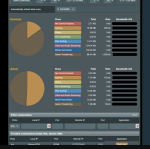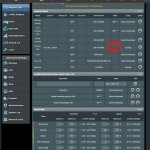Is that all the output? There should be lines for classes 1:10 - 1:17. Can you post the output of cat /tmp/flexqos_tcrules
admin@RT-AC68U-E990:/tmp/home/root# cat /tmp/flexqos_tcrules
filter add dev br0 protocol all prio 5 u32 match mark 0x8009ffff 0xc03fffff flowid 1:10
filter add dev eth0 protocol all prio 5 u32 match mark 0x4009ffff 0xc03fffff flowid 1:10
filter add dev br0 protocol all prio 5 u32 match mark 0x8006ffff 0xc03fffff flowid 1:16
filter add dev eth0 protocol all prio 5 u32 match mark 0x4006ffff 0xc03fffff flowid 1:16
filter add dev br0 protocol all prio 5 u32 match mark 0x8008ffff 0xc03fffff flowid 1:11
filter add dev eth0 protocol all prio 5 u32 match mark 0x4008ffff 0xc03fffff flowid 1:11
filter add dev br0 protocol all prio 5 u32 match mark 0x800affff 0xc03fffff flowid 1:12
filter add dev eth0 protocol all prio 5 u32 match mark 0x400affff 0xc03fffff flowid 1:12
filter add dev br0 protocol all prio 5 u32 match mark 0x8018ffff 0xc03fffff flowid 1:14
filter add dev eth0 protocol all prio 5 u32 match mark 0x4018ffff 0xc03fffff flowid 1:14
filter add dev br0 protocol all prio 5 u32 match mark 0x8004ffff 0xc03fffff flowid 1:15
filter add dev eth0 protocol all prio 5 u32 match mark 0x4004ffff 0xc03fffff flowid 1:15
filter add dev br0 protocol all prio 5 u32 match mark 0x8003ffff 0xc03fffff flowid 1:13
filter add dev eth0 protocol all prio 5 u32 match mark 0x4003ffff 0xc03fffff flowid 1:13
filter add dev br0 protocol all prio 5 u32 match mark 0x803fffff 0xc03fffff flowid 1:17
filter add dev eth0 protocol all prio 5 u32 match mark 0x403fffff 0xc03fffff flowid 1:17
filter add dev br0 protocol all prio 2 u32 match mark 0x80000000 0xc000ffff flowid 1:17
filter add dev eth0 protocol all prio 2 u32 match mark 0x40000000 0xc000ffff flowid 1:17
filter change dev br0 prio 7 protocol all handle 821::800 u32 flowid 1:17
filter change dev eth0 prio 7 protocol all handle 821::800 u32 flowid 1:17
filter change dev br0 prio 3 protocol all handle 822::800 u32 flowid 1:17
filter change dev eth0 prio 3 protocol all handle 822::800 u32 flowid 1:17
class change dev br0 parent 1:1 classid 1:10 htb prio 0 rate 460Kbit ceil 43776Kbit burst 3200b cburst 54400b quantum 5750
class change dev eth0 parent 1:1 classid 1:10 htb prio 0 rate 153Kbit ceil 9216Kbit burst 3200b cburst 11200b quantum 1912
class change dev br0 parent 1:1 classid 1:11 htb prio 1 rate 4608Kbit ceil 43776Kbit burst 4800b cburst 54400b quantum 57600
class change dev eth0 parent 1:1 classid 1:11 htb prio 1 rate 1536Kbit ceil 9216Kbit burst 3200b cburst 11200b quantum 19200
class change dev br0 parent 1:1 classid 1:12 htb prio 2 rate 460Kbit ceil 43776Kbit burst 3200b cburst 54400b quantum 5750
class change dev eth0 parent 1:1 classid 1:12 htb prio 2 rate 153Kbit ceil 9216Kbit burst 3200b cburst 11200b quantum 1912
class change dev br0 parent 1:1 classid 1:13 htb prio 3 rate 460Kbit ceil 43776Kbit burst 3200b cburst 54400b quantum 5750
class change dev eth0 parent 1:1 classid 1:13 htb prio 3 rate 153Kbit ceil 9216Kbit burst 3200b cburst 11200b quantum 1912
class change dev br0 parent 1:1 classid 1:14 htb prio 4 rate 460Kbit ceil 43776Kbit burst 3200b cburst 54400b quantum 5750
class change dev eth0 parent 1:1 classid 1:14 htb prio 4 rate 153Kbit ceil 9216Kbit burst 3200b cburst 11200b quantum 1912
class change dev br0 parent 1:1 classid 1:15 htb prio 5 rate 460Kbit ceil 43776Kbit burst 3200b cburst 54400b quantum 5750
class change dev eth0 parent 1:1 classid 1:15 htb prio 5 rate 153Kbit ceil 9216Kbit burst 3200b cburst 11200b quantum 1912
class change dev br0 parent 1:1 classid 1:16 htb prio 6 rate 2304Kbit ceil 27648Kbit burst 3200b cburst 33600b quantum 28800
class change dev eth0 parent 1:1 classid 1:16 htb prio 6 rate 768Kbit ceil 9216Kbit burst 3200b cburst 11200b quantum 9600
class change dev br0 parent 1:1 classid 1:17 htb prio 7 rate 2304Kbit ceil 27648Kbit burst 3200b cburst 33600b quantum 28800
class change dev eth0 parent 1:1 classid 1:17 htb prio 7 rate 768Kbit ceil 9216Kbit burst 3200b cburst 11200b quantum 9600
admin@RT-AC68U-E990:/tmp/home/root#



